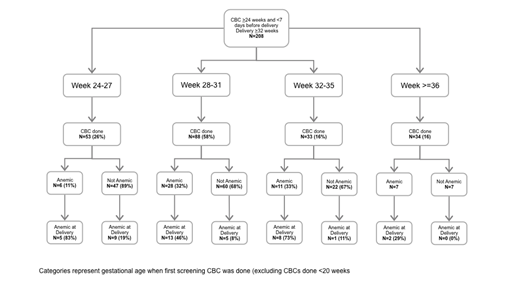Background/Objective: The World Health Organization, Centers for Disease Control, and the American College of Obstetricians and Gynecologists recommend screening for anemia in pregnancy. While screening is commonly performed in the second half of pregnancy to prevent anemia at delivery, few guidelines specify a gestational age when screening should occur. Our primary study objective was to examine whether gestational age (GA) at anemia diagnosis is associated with anemia at delivery. Secondarily, as Tennessee is one of 17 states with statues requiring third trimester HIV screening, we also assessed whether bundling of common screening labs, especially state-mandated third trimester HIV screening, is associated with later anemia screening in pregnancy.
Study Design: We performed a retrospective cohort study of all outpatient pregnant women who had a CBC done at >=24 weeks, delivered at >= 32 weeks, and had a CBC within 7 days of delivery between 1/1/19 and 1/31/19. Anemia was defined as a hemoglobin (hg) <10.5g/dL between 24-27 weeks and <11g/dL at >=28 weeks. The primary exposure was gestational age when anemia was first diagnosed. Relevant covariates included maternal age, race/ethnicity, and comorbidities associated with anemia such as hemoglobinopathies and malabsorptive disorders. The primary outcome was anemia at delivery and secondary outcome was mean Hg at delivery. Anemia screening was defined as the first CBC performed >=24 weeks and anemia diagnosis was defined by the earliest GA at >= 24 weeks when anemia was diagnosed. Bundling of screening tests was defined as performing HIV and/or glucose tolerance testing (GTT) on the same day as the CBC versus testing on different days. We constructed logistic and linear regression models to examine the association between both anemia at delivery and hg at delivery, and gestational age of anemia diagnosis, adjusted for covariates.
Results: Of 208 women meeting inclusion criteria, 53 (26%) women were anemic at delivery with a mean Hg of 10.0+1.0 g/dL. Later anemia diagnosis (in weeks) was associated both an increased odds for anemia at delivery (aOR 1.06, 95% CI 1.04-1.09) and a decreased Hg level at delivery. Specifically, each week later that anemia was diagnosed resulted in a 0.04 decrease in Hg at delivery (-0.04, 95% CI -0.06 to -0.03). These findings were unchanged after adjusting for maternal age, race, and comorbidities. The timing of anemia screening and frequencies of anemia are displayed in Figure 1. The majority (58%) of anemia screening occurred between 28-31 weeks and anemia screening was frequently done either in conjunction with HIV (73%), GTT (36%), or both (29%). Anemia screening was more likely to occur in conjunction with HIV screening at 28-31 weeks (OR 3.47, 95% CI 1.39-8.63) compared to 24-28 weeks.
Conclusions: One quarter of pregnant women are anemic at delivery, which is associated with later diagnosis of anemia in pregnancy. Bundling of screening labs, particularly state-mandated HIV testing, may impact timing of anemia screening in Tennessee, which suggests unintended consequences of well-intended health policies.
No relevant conflicts of interest to declare.
Author notes
Asterisk with author names denotes non-ASH members.


This feature is available to Subscribers Only
Sign In or Create an Account Close Modal